翻译的定义、分类和标准
英语翻译的基本常识解析

翻译的基本知识一、翻译的定义奈达:Translation consists in reproducing in the receptor language the closest natural equivalent of the sourcelanguage message, first in terms of meaning andsecondly in terms of style. —— Eugene A. Nida二、翻译的标准奈达:The receptors of a translation should comprehendthe translated text to such an extent that they canunderstand how the original receptor must have understood the original text.——Eugene A. NidaEugene A. Nida (November 11, 1914 – August 25, 2011)was the developer of the dynamic-equivalence Bible-translation theory.四、翻译的方法1 . 直译(Literal translation)例子: C.O.D. (cash on delivery) 货到付现blue chip 蓝筹股一箭双雕hit two hawks with one arrow意译(Free translation)例子:WPA 水渍blue chip 绩优股一箭双雕kill two birds with one stone一、广告的定义Advertising is the non-personal communication ofinformation usually paid for and usually persuasive innature about products, services or ideas by identifiedsponsors through the various media.—— American Marketing Association二、广告的分类1.理性广告(Rational ads)情感广告(Emotional ads)三、广告的组成部分1.Headline Subhead Text (body) Logo sloganI’m lovin’ it! (麦当劳)我就喜欢!Good to the last drop. (Maxwell coffee)滴滴香浓,意犹未尽。
翻译的概念
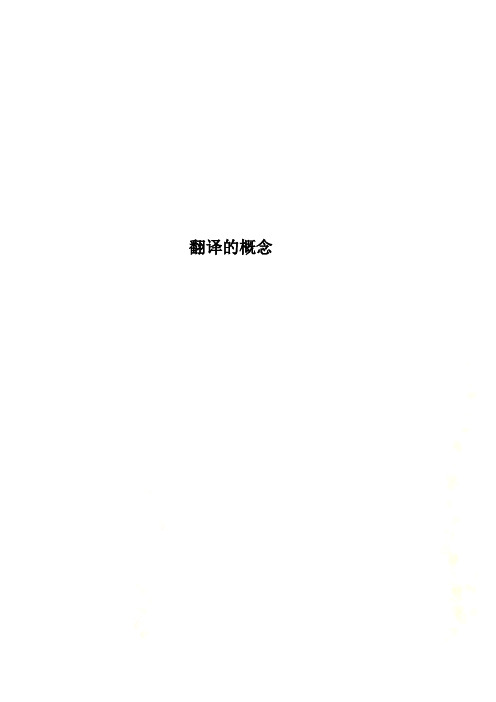
翻译的概念第一章第一节翻译的概念,分类,过程及方法一.翻译的概念1.关于翻译的几种定义①翻译是一门艺术.(Translation is a fine art.)----林语堂《翻译论》②翻译是一门科学.----董秋斯③Translation consists in reproducing in the receptor language the closest natural equivalent of the source language, first in terms of meaning and secondly in terms of style.----尤金.奈达2. 广义的翻译是指语言与语言,语言变体与语言变体,语言与非语言等的代码转换和基本信息的传达.3.狭义的翻译是一种语言活动,是把一种语言表达的内容忠实地用另一种语言表达出来.二. 翻译的分类1.按所涉及的两种代码的性质分为:语内翻译(intralingual translation):同一种语言间不同语言变体的翻译.语际翻译(interlingual translation):不同语言间的翻译,是狭义翻译的研究对象. 语符翻译( interseniotic translation):用非文字符号解释文字符号.2.按翻译主体的性质分为人工翻译和机器翻译两类.nextexercise3.按照翻译的工具和成品形式可分为口译和笔译.4.按翻译的客体即所译资料的性质可分为文学翻译(literary translation):包括诗歌,小说,戏剧等文学作品的翻译,着重情感内容和修辞特征的表达.实用翻译(pragmatic translation):包括科技,商务,公文等资料的翻译,着重实际内容的表达.三. 翻译的过程翻译的过程是理解和表达的有机结合.翻译的关键在于对原文的理解,要真正理解原文,译者必须有扎实的语言功底和相关专业背景知识,并熟知英汉两种文化知识,否则译者就不能真正理解,从而产生误差.例:Cannot Beat the Real Thing.(美国可口可乐广告)不能打败真正的商品.挡不住的诱惑!next后者简单明了的把原文的真正含义表达了出来,能达到打动消费者的目的.表达阶段就是译者把自己从原文所理解的内容用目的语重新表达出来.表达的好坏主要取决与对原文的理解深度和对译文语言的饿修养程度.理解原文不是易事,表达亦然.例:As we obtained a clean B/L, you will see that the goods were slopped in good order. We suggest, therefore, that you lodge your claim with it. 由于我们获得了清洁提单,所以你们将明白货物在装运时情况良好,且被安放的井井有条.由此看来我们建议你们可以向该轮船公司提出索赔.我方已获得清洁提单一张,贵方谅必清楚货物装船时状况良好,因此建议贵方可依此向该轮船公司提出索赔.四. 翻译的方法1.直译和意译是翻译的两大基本方法.2.所谓直译是指翻译时要求译文与原文在词语,语法结构及表达方式上保持一致的方法.例:Many investors no longer treat a stock as an instrument of ownership in a corporation but only as a derivative of economic factors, risks and potentials.许多投资者不再把他们拥有的股票看作是拥有某一公司一部分权益的工具,而只是将它视为经济因素,风险,潜力的衍生物.See morenext3.意译是指摆脱原文形式的束缚而传达原文的内容.During Federal Reserve Chairman Greenspan's nearly 20 years as the world' most powerful central banker, the U.S has suffered only one recession, a brief one in 1990-1991.格林斯潘作为全球最有实力的中央银行的掌舵人,在其近20年的任期中,美国仅在1990-1991年间遭受过一次短暂的经济萧条.本句意译主要体现在句子结构层面上,将only one recession和a brief one in 1990-1991进一步融合,更加符合汉语的表达习惯.讨论翻译的概念, 分类,过程及方法并提出自己的看法和观点.将下列汉语译成英语:1.语内翻译_______2.语际翻译_______3.语符翻译_______4.文学翻译_______5.实用翻译_______6.功能对等_______7.机器翻译_______8.目的语_______9. 源语_______三.结合直译和意译两种翻译方法,将下列英语译成汉语:1.Translation may be defined as follows: the replacement of material in one language (SL) by equivalent textual material in another language.2.A translation should give a complete transcript of the same character as that of the original. A translation should have all the ease of the original composition.3. Automatic package has been adopted into production of almost every industry.4.A compensation package often includes a base salary, an annual bonus and some other extra rewards and benefits.5. A packaged service called Trade Web costs companies less than 1,000$a year to join. It is so cheap that 3,000 small suppliers have signed up with the operator.6.The through quality management is apparent not just in the products, but also in the system through a self-check system and tracebility at each stage of production from the greenhouse to the table.第二节商务英语和商务文本翻译标准exercise一. 商务英语的界定商务英语是英语的一种功能变体,是专门用途英语(English for Specific Purposes)中的一个分支,适于商务场合中应用,或者说是一种包含了各种商务活动内容,适合商业需要的标准英文.而这些商务活动包括技术引进,对外贸易,招商引资,对外劳务承包与合同,国际金融,涉外保险,国际旅游,海外投资,国际运输等等, 在这些活动中使用的英语统称为商务英语(Business English )二.商务文本的翻译标准商务文本的复杂性决定了商务文本的翻译标准必须是多元化的,不同的商务文体该有不同的翻译标准.1.商务广告的翻译:"劝购功能相似"广告的主要功能是劝购功能,即说服读者去买广告中所宣传的产品或服务.广告翻译是否成功取决它是否能在译文读者中取得同样的作用.广告翻译应以"劝购功能相似"为其基本原则, 译文应与原文有大致相同的宣传效果,信息传递功能和移情感召功能.需要强调的是,由于语言之间存在的差异以及译文读者和原文读者的社会和文化背景不同,广告翻译的"功能相似"原则并不是要求字字对等的"忠实"翻译而是一种极为灵活的对等:即广告翻译的受众是否象原广告的受众一样乐于掏钱买商家所宣传的广告产品.例:We take no pride in prejudice.( The Times 的一则广告)译文1:对于你的偏见,我们没有傲慢.译文2: 对于有失偏颇的报道,我们并不引以为豪.参考译文:正义的力量,舆论的向导.>>>examplePride in prejudice引用英国作家简.奥斯汀的名作《傲慢与偏见》,体现了《泰晤士报》秉承公平,公正的办报原则,收到了很好的广告效果.但由于中西方的文化差异,使这种效果很难在译文中表现出来.译文1将《傲慢与偏见》的两个关键词强加到译文中,但却使人看了之后不知所云.译文二虽然表达了公平公正的意思,但给人的感觉是《泰晤士报》不总是报道真实的新闻.在这种既难保留原文,又难达到广告宣传目的的两难情况下,则可放弃原文,采取另译的方法例句分析Quality Services for Quality Life.凝聚新动力,文康展新姿._香港康乐及文化事物署的双语广告Connecting People.科技以人为本._诺基亚公司的广告词★商务广告的翻译next2.商务应用文的翻译:约定俗成,入乡随俗.商务应用文在此具体是指商务活动中的项目招商通告,营业执照,招投标文件,请柬等具有固定行文格式的商务文件.>>example★商务应用文的翻译The Deputy Prime Minister of Australiaand minister for Overseas TradeDr.J.F. CairnsRequests the Pleasure of Your Companyat a BanquetOn Tuesday, 11 October, 2005from 12:30 to 13:30 p.m.in Hall Three of the Beijing Exhibition CenterTo Mark the Opening of the Australian ExhibitionR.S.V.PTel:_______Chinese★商务应用文的翻译谨订于2005年10月11日(星期二)12时半至下午1时半假座北京展览馆3号大厅举行宴会,庆祝澳大利亚展览会开幕.敬请光临澳大利亚副总理兼海外贸易部长杰.弗.凯恩斯博士(请赐复)电话________next3. 商务信函的翻译: 事实准确,礼貌得体根据商务信函的语言特点和实际用途,商务信函的翻译应遵循以下原则:⑴准确传达原文的事实信息主要包括三个方面:术语翻译规范,具体事实细节准确传译, 一般性叙述用词恰当.⑵贴切再现原文的礼貌语气商务信函属于公函语体,措辞严谨,语气委婉,注重礼节,翻译是要特别注意再现原文的礼貌语气.⑶符合公函文体的语言特征>>example★商务信函的翻译There are qualities of this item here, in different weights and size, with varied colors and shapes. The price is very reasonable and the quotations will be given upon request.Our prices already make full allowance for large orders and , as you know, we operate in a highly competitive market in which we have been forced to cut our prices to minimum.我方现有各种不同重量,不同体积,颜色丰富,形状各异的大理石,数量甚巨,价格合理,受函抱价.我方抱价已考虑到大批量定货的因素.相信贵公司了解我们是在一个竞争十分激烈的市场上经营销售业务,因而已经不得不把利润降到最低限度.next4. 商务合同的翻译⑴商务合同的概念:是一种契约文体,其文体具有用语正式,句式严谨以及篇章结构固定等特点.⑵具体标准:*用词准确,译文完整*行文通顺,条理清楚*符合契约的文体特点>>example★商务合同的翻译The date of receipt issued by the transportation department concerned shall be regarded as the date of the delivery of goods.Payment: By irrevocable L/C at the sight to reach the sellers 30 days before the time of shipment.The buyer shall make a claim against the Seller (including replacement of the goods) by the further inspection certificate and all the expenses incurred therefore shall by the Seller.The arbitral award is final and binding upon both parties.Chinese★商务合同的翻译由有关的运输机构所开据收据的日期视为为交货期.买方应在装船前30天将不可撤消的即期信用证开到卖方.买方需凭复检证明书向卖方提出索赔(包括换货),由此引起的全部费用应由卖方负责.仲裁机构的裁决具有最终效力,双方必须遵照执行.一.讨论翻译及商务英语翻译的标准.二.将下列英语短语译成汉语:1.form a receipt __________________2.ticket order form ___________________3.application form ___________________4.an active list ___________________5.an export list ____________________>>>more三.将下列英语段落翻译成汉语.Speaking of translation, we tend to think of Yan Fu who advocated for the first time the three words as translation criteria, namely, "faithfulness, expressiveness and elegance". Yan Fu's "faithfulness" means the fulland complete conveying or transmission of the original content or thought. His "expressiveness" demands that the version must be clear and flowing without any grammatical mistakes or confused logic and sense. But his "elegance" is unadoptable because it refers to the use of classical Chinese before the Han Dynasty, Yan Fu held that only the language before the Han Dynasty could be considered elegant and old vocabulary, the old structure of Chinese must be used in order to represent the original fully and adequately."Faithfulness" first refers to the content of the original work. The translator must bring out the original meaning both comprehensively and accurately without any distortion or casual addition or deletion of the original thoughts.Faithfulness also includes the keeping of the original style, as Mr. Lu Xun put it , "keep the full flavor of the original work."第三章涉外商务信函的翻译第一节商务信函简介一商务信函的12种要素信头(letterhead)案号(reference)日期(date)封内地址(inside address注意项(attention line)称呼(salutation)事由栏(subject)信的正文(body of letter)信尾敬语(complimentary close)签名(signature)缩写名,附件及分送标志部分(IEC: initials, enclosures and carbon copies block)附言(postscript)Next商务信函实例1Kee & Co., Ltd34 Regent StreetLondon, UK Inside Address 收信人地址Dear Sirs,Salutation称呼We have obtained your name and address from Dee&Co. Ltd, and we are writing toenquire whether you would be willing to establish business relations with us.We have been importers of shoes for many years. At present, we are interested in extending our range and would appreciate your catalogues and quotations.If your prices are competitive we would expect to place volume orders on you.We look forward to your early reply._Yours faithfully, Complimentary Close客套结束语Tony Smith Signature Block签名栏Enc: invoice for consulting services Enclosure Notation_商务信函实例21117 The High RoadAustin TX 787036 June 2006MR. David Patricks3005 West 29th, Suite 130Waco. TX 77663Dear Mr. Ptricks,I received your June 5th letter requesting consultation and am providing myrecommendation in the following.First, let me review my understanding of your inquiry. The question you raise revolvesaround whether the heating registers should be located in a low sidewall, or in the ceiling,and if ceiling registers are used, which type –step –down or stamped-faced—will deliverthe best results. Additionally, the problem concerns whether there is any benefit to haveheating registers near the floor, whether moving heated air "down" in ducts negativelyaffects blower performance.My recommendations are as follow:I can find nothing in either Carrier, Trane, or ASHRAE design manuals that indicatesdrop as being a factor in duct design any different from normal static losses. If you havedifferent information on this, I would like to have references to it.I cannot see any advantage to low sidewall application. The problem is injection and pattern. I do see an advantage to low sidewall return; Carrier Design Manual—Air Distribution is a good reference on both items.I recommend step-down diffusers with OBD because they have pattern and volume control that is superior to stamped-faced diffusers.I am opposed to low sidewall diffusers or floor diffusers in the application you describe. The increased static losses that result from trying to get the ducts to down through the walls will only increase installation cost and reduceefficiency.If there is anyone in your organization who is uncomfortable with these recommendations, let me know. I'd be very interested in reviewing any actualdocumented test results. Let me know if you have any further questions or if Ican be of any further assistance.Sincerely,Jane A McMurreyJane A McMurrey, P.E.HVAC Consultant, Inc.JAM/dmcEncl.: invoice for consulting services2 涉外商务信函语篇风格的特点,也称7C原则2.1 完整(completeness)2.2 简洁(conciseness)2.3 具体(concreteness)2.4 正确(correctness)2.5 清晰(clarity)2.6 体谅(consideration)2.7 礼貌(courtesy)2.1 完整(completeness)实例解说:"Cellulose Tape 1/2"x 3yds, with plastic dispenser 700 doz./ditto-but 1/2" x 5 yds, 1,000doz."这是出口商接到的一份定单中有关商品品名,规格和数量的内容.中文意思是:"纤素带(幅)宽半英寸,长3码,带塑料包装容器,700打;同上,但(幅)宽宽半英寸,长5码,1000打."问题是后半句不清楚. "ditto"在这里表示前面提到的商名称纤维素带, 但不能包括"带塑料包装容器",因此,幅英寸长5码的纤维素带是否要塑料包装容器没有说清楚,不完整.所以最好改成:"Cellulose Tape 1/2"x 3yds, with plastic dispenser 700 doz. CelluloseTape 1/2" x 5yds,with plastic dispenser 1000 doz." 这样既完正,又清楚明确,不引起误解.2.2 简洁(conciseness)"简洁"是有客观标准的.虽然西方国家的作者之间在怎样用词才算"简洁"方面还是有争论的,不过他们的一些看法还是有一定参考价值的.怎样才能使商业书信"简洁" 西方国家作者有很多建议,先介绍如下:eg 2;(一) 避免使用陈旧的商业术语陈旧的与传统的商业术语(Commercial jargon)对信的内容没有什么作用,应该避免使用.Eg 1:Wordy: We wish to acknowledge receipt of your letter of November 14 with the check for Stg.10 enclosed and wish to thank you for same Concise: We appreciate your letter of November 14 and the check for Stg.10 you sent with it.例二:Wordy:We take liberty to approach you with the request that you would be kind enough to introduce to us some exporters of cotton textiles in your cities. Would you please introduce to us some exporters of cotton textiles in your cityConcise:Please introduce to us some exporters of cotton textiles in your city. (二) 要长话短说,避免罗嗦通常商业人士每天需要阅读大量的书信,对开门见山,长话短说,直接切题的信特别欢迎.因此, 写信要力求长话短说,例如:不要写Please see that an enquiry is conducted to determine the reason.应写作Please find out the reason.不要写We express our regret at being unable to fulfill your order on this occasion.应写作We are sorry we cannot meet your present order.要使用简洁的语言,有可能的话, 尽量使用单词来代替某些娇柔做作的短语.删去不必要的形容词,如下列句子中的形容词或副词删去后并不影响句子的原意: The proposal is under (active) consideration.The answer is (definitely) correct.I would (rather) think the fare is too high.The (true) facts are as stated .(三) 要注意每句句子的长短例如:"We would like to know whether you would allow us to extend the time of shipment for twenty days, and if you would be so kind as to allow us to do so, kindly give us your reply by cable without delay."这句话过分"客气",使句子过长而不清楚.内容要求对方同意延期交货20天,一般情况下,应尽可能提出延期到那一天的具体日期.这句话可压缩为:"Please reply by telegram immediately if you will allow us to delay theshipment until April 21."2.3 具体(concreteness)2.4 正确(correctness)商业书信必须写得正确,因为它涉及到买卖双方的权利,义务,厉害关系,是各种商业单据(如合同)的根据. 广义的说,商业书信的正确性表现在:(一) 运用正确的语言水平(二) 叙述得正确(三) 数字要正确(四) 正确理解和运用商业术语(五) 合适的写作技巧或方法,以及正确运用其他的六个"C".(一) 运用正确的语言水(二)叙述得正确叙述得正确: 商业书信的内容要叙述得正确,既不要说得不够(Understatement),更不要说得过头(Overstatement).[例一]This stove is absolutely the best (or: the very best) on the market.(这种炉子是市场上绝对最好的炉子.)这句话是用来介绍商品的, 但没有具体介绍商品的性能, 而是抽象地断定这种炉子是"市场上最好的".这样介绍商品,不但不能达到推销的目的,反而使人对写信人有"卖狗皮膏药"的感觉.[改写]Our model A195 is designed on modern lines, without any increase infuel consumption, 25% more heat than the older models. So you will agree that it is the outstanding stove for economy of fuel.(我们的A195型炉子是按近代样式设计的,在不增加燃料消耗的情况下,比其他各种旧式炉子温度高25%.所以,你会同意,这是优良的节约燃料的炉子.)(三) 字要正确字要正确:做对外贸易离不开数字. 对商业书信中的数字的正确性要特别加以注意,有时"失之毫厘,差之千里".甚至引起不同的理解.(a)"以上","以下","以前","以后","从….到... "等的表达法(b)二美元和二美元以上$2 or (and)$2 above (over)不少于50罗的定单50gross or (and) up (upward, upwards)(四) 正确理解和运用商业术语理解和运用商业术语:一般常用的商业用语用字简洁,意义明确,使用得好,工作进行得顺利,使用得不好,就会引起混乱,误解,甚至产生不必要的纠纷.如:You ask very short delivery for your order.写信的人原意是说"你们要求赶快交你们的定货."可是short delivery不是快点交货的意思,而是"短交"的意思,这就用错了商业术语.因此,应该说:Your require quick (prompt) delivery of your order.(五)正确运用其他的六个"C".2.5 清晰(clarity)(一).避免使用可能产生不同理解或意义不明确的词〈例一〉As to the steamers sailing from Hongkong to San Francisco, we have bimonthly direct services.(从香港到旧金山有直达船,) 但是bimonthly 究竟是一个月两次即半月一次呢,还是两个月一次不明确.因此,最好清楚明白说明"一个月两次"还是"两个月一次"(a) We have two direct sailings every month from Hongkong to San Francisco.(每月两次直达船)(b) We have semimonthly direct sailing from Hongkong to San Francisco. (每半月一次直达船)(c) We have a direct sailing from Hongkong to San Francisco every two month.(每两个月一次直达船)(二)注意修饰词的位置,有时修饰词的位置不同,会导致不同的含意如:a) Please let us know what you wish us to do about this matter as soon as possible;b) Please let us know as soon as possible what you wish us to do about this matter.以上两句中的""修饰的内容不同:a) 你们要求我们尽快做些什么.b) 请尽快告诉我们.a) 可译成"请告诉我们你们要我们为此尽快做些什么";b) 可译为"请尽快告知,你们要我们为此事做些什么".(三) 注意代名词,关系代词和先行词的关系按照英语习惯, 句子中的代名词和关系代词一般是指离得最近的名词,因此要特别注意,以免引起误解或不清楚.例句:不好:They informed Messrs. John & Smith that they would receive an answer in a few days.较好: They informed Messrs. John & Smith that latter would receive an answer in a few days.(四)注意前后一致和紧凑,连贯不一致:Being a certified public accountant, I am sure you can help us.一致:Being a certified public accountant, you can surely help us. or; As you are a certified public accountant, I am sure you can help us.(五)仔细和恰当地分段落商业书信要写得使人一读就明白,因此必须按照内容仔细和恰当的分段落,一般的分段落原则是一个段落一个意思(A paragraph for each point is a good general rule.). 现举例说明:Dear Sirs,It is reported in a domestic newspaper that the Iranian Central Bank hasinstructed the commercial banks to suspend their business of opening a new letter of credit as from the 3rd May for financial reason of foreign currency. Although it is said that this arrangement would be a temporary one and with establishment of new import policy this emergency arrangement would be lifted, we are much concerned about the outcome of this movement toward restriction of import to Iran and shall be obliged if you will kindly keep us well advised of development of this new arrangement especially in connection with import from France.Yours faithfully,以上这封信只有一段,供两句.第一句39字,第二句66句. 读后虽然能基本了解其内容, 但读起来很舒服.信的内容大体有三点:1. 伊朗中央银行因外汇原因,通知个商业银行从五月三日起停止开立信用证;2. 这临时措施,新的进口政策一订,这个措施可能取消;3. 希望对方随时告之有关情况.按照这三点,适当地分段,把信重新改写,读起来比原来的清楚易懂:Dear Sirs,It is reported in a vernacular newspaper that the Iranian Central Bank has instructed the commercial banks to suspend their issuing new Letters of Creditas from the 3rd May because of its decreasing foreign currency funds. Furthermore it is said that the suspension seems a temporary one and willbe released with establishment if a new import policy.We are much concerned, however, about the outcome of this movement toward restriction of import to Iran.We, therefore, shall be obliged if you will keep us well informed of development of this new state of affairs, especially in connection with importsfrom France.Yours faithfully,2.6 体谅(consideration)2.7 礼貌(courtesy)COURTESY译成"礼貌".但是根据西方国家函电书籍作者普遍的看法,所谓COURTESY是"客气而又体谅人"的意思.这样的形式很多,现在提供一些常见的供参考:(一) 把命令变成请求的常用形式: Please, Will you…….., Will you please……..,如:a) Will you give us more detailed information on your requirementb) Will you please (kindly) let us hear from you on these two points(二) 虚拟式(Past Subjunctive From)如:a) Would you compare our sample with the goods of other firmsb) We would ask you to ship the goods by the first available vessel.c) We wish you would let us have your reply soon.d) This would seem to confirm our opinion.e) We should be grateful if you would help us with your suggestion.f) We might be of some service to you in a similar case.以上的b, 也可用will, shall, may, 但是用Past Subjunctive Form则表示更客气和婉转些.2.7 礼貌(courtesy)(三) 缓和用法(Mitigation)为了缓和过分强调或刺激对方,常用: We are afraid, we would say, we may(or, might) say, we(would) think, it seems(or would seem) to us, we(would) suggest, as you are (or: may be) aware, as we need hardly point out等等表达法来缓和语气,如:_a) It was unwise of you to have done that.We would say that it was unwise of you to have done that._b) You ought to have done it.It seems to us that you ought to have done it.c) We cannot comply with your request.We are afraid we cannot comply with your request.d) Our products are the very best on the market.We might say that our products are the very best on the market.符合7C原则的信函实例Dear Sirs,Our client in Mumbai requests us to obtain from you a pro forma invoice for color TV setsWith the following specifications: "Haier" brand color TV sets 25-inch and 34-inch(each 500sets).Would you please airmail us the soonest possible your pro forma invoice for 1,000 color TVsets with prices CIF Mumbai, so that we obtain our client's confirmation. There is no questionabout our getting the necessary import license from our authorities.As soon as the said license is approved, we shall establish an L/C in yourfavour.Thank you for your close cooperation in this respect. Yours Sincerely, John Smith敬启者:我们的一个孟买客户要求我们从贵方取得下列规格的彩色电视机形式发票:"海尔"彩色电视机25英寸和34英寸各500台.请尽快航邮注有孟买到岸价格的1,000台彩色电视机的形式发票,以便我们取得客户认.从当局取得必要的进口许可证当无问题.一俟获得许可证即开以贵方为受益人的信用证.感谢贵方的密切合作.你真诚的, 约翰.史密斯第二节商务信函的文体特点及其翻译1 商务信函的文体特点1.1 词汇使用特点1.1.1 用词规范正式1.1.2 表意准确,专业性强1.1.3 用语朴素,淡于修饰1.2 语法使用特点1.2.1 句子类型1.2.2 句式结构(1)复合句与简单句结合,以复合句为主(2)常用并列结构(3)状语位置独特1.2.3 虚拟语气的运用2 商务信函的翻译要点2.1 商务英语信函翻译的原则2.2 商务英语信函翻译的注意事项1 商务信函的文体特点1.1 词汇使用特点1.1.1 用词规范正式(1)商务英语信函经常以意义相同或相近的书面词语代替基本词汇和口语词汇,如以inform或advise代替tell,以duplicate代替copy,以dispatch代替send,以otherwise代替or;以介词短语代替简单的介词,如以as for,in respect to,in connection with和with regarding to等代替about等.例如:We are pleased to advise you that your order NO.105 has been dispatched in accordance with your instruction.我们很高兴地通知你们:第105号订单货物已遵照你方指示运出.1.1.1 用词规范正式We will meet you half way by offering a discount of 5% in view of our long pleasant relations.鉴于我们之间长期愉快的业务关系,本公司将酌情考虑给予5%的折扣.(2)商务信函中还经常使用here/there +介词构成的复合词,如hereafter,hereby,hereunder,hereto,hereinafter,herewith,thereafter,therein,therefrom等.例如:All offers and sales are subject to the terms and conditions printed on the reverse side hereof.所有报盘和销售均应遵守本报价单背面所印的条款.In such a case, Seller is bound to reimburse Buyer for any loss or damage sustained therefrom.在次情况下,卖方负责偿还买方由此所遭受的损失.1.1.2 表意准确,专业性强商务信函用词表意准确,专业性强,主要表现在使用大量的专业术语,行话,外来词,缩略语以及一般词语在商务英语语境中的特殊用法.(1)专业术语类:Trimming charges 平仓费insurance policy 保险单coverage 保险项目establishment 开证counter-suggestion 反还盘surcharges附加费pro forma invoice形式发票premium保险费clearance sale清仓削价销售underwriter 保险人L/C 信用证CIF 到岸价格FOB离岸价格bid 递盘C.B.D. 付现提货counter-offer还盘irrevocable letter of credit 不可撤消信用证1.1.2 表意准确,专业性强例如:We shall cover TPND on your order.我们将为你方的货物投保盗窃和提货不着险.It would be appreciated if you would let us know by returning your lowest possible price for the following goods on FOB London.请报下列商品伦敦船上交货之最低价.(2)外来词类:拉丁语的status quo(现状),意大利语的del credere(保付货价的),汉语中的litchi(荔枝),tungoil(桐油),mango(芒果)等.(3)行话:长期的函电交往使人们在使用术语上形成共识,本来意义差异很大的词汇在特定的语境中所表达的内涵和外延却非常相似.Offer, quotation表示"报价,发盘"Pamphlet, brochure, booklet, sales literature 表示商家用于宣传介绍自己公司或产品的"说明材料"Shipment和consignment 表示"所发出的货物"Financial standing/reputation/condition/position用于表示公司的"资信财务情况"Fulfill/complete/execute an order用于表示"执行订单"A draft contract或a specimen contract 表示"合同样本"1.1.2 表意准确,专业性强(4)商务信函准确性主要体现在数量词的大量运用.商务信函中的时间,价格,数量,金额,规格等问题贯穿商贸活动始终,数字的表达应言之确凿,避免摸棱两可.例如:。
翻译规范及其研究途径

翻译规范及其研究途径翻译规范是翻译研究中不可忽视的一个重要领域。
不同的语言和文化背景,决定了翻译规范的多样性。
在翻译过程中,我们不仅要考虑语言的转换,还要文化背景的差异,以确保翻译的准确性和可读性。
本文将探讨翻译规范的定义、分类及其研究途径,旨在提高翻译质量和效率。
一、翻译规范的定义与分类翻译规范是指在进行翻译活动时所应遵循的原则和标准。
这些原则和标准可能涉及到语言、文化、社会、心理等多个方面。
根据其性质,翻译规范可分为以下几类:1、语言规范:涉及源语言和目标语言之间的词汇、语法和句法转换的规范。
这些规范确保了翻译的准确性和可读性。
2、文化规范:涉及文化背景和价值观差异的规范。
在翻译过程中,需要尊重和保留原文中的文化元素,同时将其融入目标语言的文化背景中。
3、社会规范:涉及社会习惯和礼仪的规范。
在翻译过程中,需要了解并遵循目标语言的社会习惯和礼仪,以使译文更符合目标读者的期望。
4、心理规范:涉及心理活动和认知过程的规范。
在翻译过程中,需要分析和把握原文作者和目标读者的心理活动,以确保翻译的有效性和说服力。
二、翻译规范的研究途径要研究翻译规范,我们可以采取以下途径:1、对比分析法:通过对源语言和目标语言的词汇、语法、句法等进行对比分析,找出差异与相似之处,为翻译实践提供指导。
2、语料库研究法:利用语料库资源,对大量的翻译实例进行统计分析,总结出翻译规范和技巧。
3、实证研究法:通过实验和调查等手段,对翻译过程中的心理活动、社会因素等进行分析,揭示翻译规范的实际情况和应用效果。
4、跨学科研究法:将翻译学与其他相关学科(如语言学、文化学、心理学等)进行跨学科研究,深入探讨翻译规范的内在机制和影响因素。
三、翻译规范的应用与评估翻译规范的应用贯穿于整个翻译过程,包括准备阶段、翻译阶段和审校阶段。
在每个阶段中,翻译规范都发挥着指导作用,帮助我们做出合理的决策。
同时,我们也需要对翻译规范的应用进行评估。
评估可从以下几个方面进行:1、准确性评估:译文是否准确地传达了原文的意思?是否避免了歧义和误解?2、流畅性评估:译文是否通顺、易读?是否符合目标语言的表达习惯?3、文化适应性评估:译文是否适应该目标语言的文化背景?是否保留了原文中的文化元素?4、社会认可度评估:译文是否符合目标语言社会的价值观和习惯?是否得到了目标读者的认可?总之,了解并遵循翻译规范是提高翻译质量的关键。
新编汉英翻译教程陈宏薇9787544631914整理笔记

第一章绪论1.1 翻译的性质和分类1. 翻译的定义:Definition of translation翻译是将一种语言文化承载的意义转换到另一种语言文化中的跨语言、跨文化的交际活动。
翻译的本质是释义,是意义的转换。
2. 翻译的分类:Classification of translation按文本而言,分为文学翻译、科级翻译、应用文翻译就方式而言,分为全译、摘译、编译。
全译:全文照译,全译是翻译的最基本方式,它是翻译的基础。
摘译:根据特定目的的摘取、翻译原文中的部分内用,以利译文读者更方便,更快捷的获取原文文献主要信息的方式。
编译:则是“编辑”和“”翻译的结合。
3.翻译活动涉及的因素:Factors involved in translation activities译者:translator, 作者:author, 原文: source text,原文读者: source-text readers译文:target text/translated text/target version, 译文读者: target-text readers1.2 汉英翻译的单位----句子C-E Translation Unit句子:句子是用词或词组构成的一个能够表达一个完整意思的语言单位。
每个句子都有一定的语调,表示陈述、疑问、祈使、感叹等语气。
在连续说话时,句子和句子中间有一个较大的停顿。
在书面上,句子的停顿处,要根据不同的语调分别用句号、问号火感叹号。
(定义来自《汉语大辞典》)从意义上讲,句子能够表示一个完整的意思从功能上讲,句子表示陈述、疑问、祈使、感叹等语气从形态上讲,句末有句号、问号或感叹号为标志因此,句子是较为理想的翻译单位。
1.3 汉英翻译的标准Standards for C-E TranslationChinese translation standards1.严复的标准信:faithfulness 指准确的传达原文的内容,即信于读者和作者,不允许对原作有任何歪曲或篡改,译作不容许有任何遗漏和省略。
非文学翻译基础知识
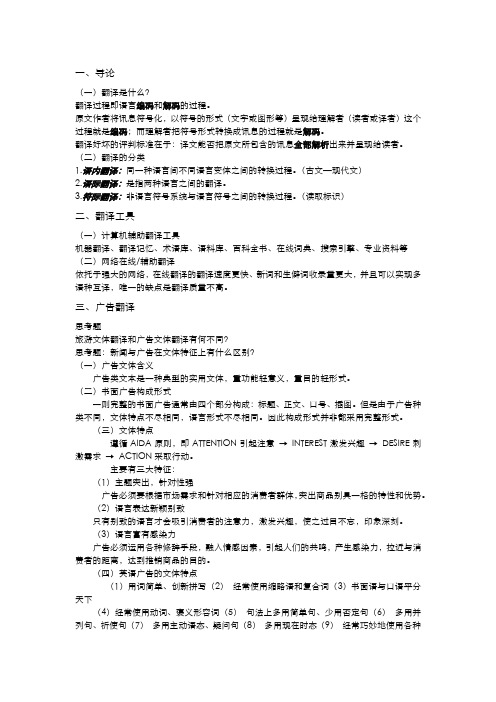
一、导论(一)翻译是什么?翻译过程即语言编码和解码的过程。
原文作者将讯息符号化,以符号的形式(文字或图形等)呈现给理解者(读者或译者)这个过程就是编码;而理解者把符号形式转换成讯息的过程就是解码。
翻译好坏的评判标准在于:译文能否把原文所包含的讯息全部解析出来并呈现给读者。
(二)翻译的分类1.语内翻译:同一种语言间不同语言变体之间的转换过程。
(古文—现代文)2.语际翻译:是指两种语言之间的翻译。
3.符际翻译:非语言符号系统与语言符号之间的转换过程。
(读取标识)二、翻译工具(一)计算机辅助翻译工具机器翻译、翻译记忆、术语库、语料库、百科全书、在线词典、搜索引擎、专业资料等(二)网络在线/辅助翻译依托于强大的网络,在线翻译的翻译速度更快、新词和生僻词收录量更大,并且可以实现多语种互译,唯一的缺点是翻译质量不高。
三、广告翻译思考题旅游文体翻译和广告文体翻译有何不同?思考题:新闻与广告在文体特征上有什么区别?(一)广告文体含义广告类文本是一种典型的实用文体,重功能轻意义,重目的轻形式。
(二)书面广告构成形式一则完整的书面广告通常由四个部分构成:标题、正文、口号、插图。
但是由于广告种类不同,文体特点不尽相同,语言形式不尽相同。
因此构成形式并非都采用完整形式。
(三)文体特点遵循AIDA原则,即ATTENTION引起注意→INTEREST激发兴趣→DESIRE刺激需求→ACTION采取行动。
主要有三大特征:(1)主题突出,针对性强广告必须要根据市场需求和针对相应的消费者群体,突出商品别具一格的特性和优势。
(2)语言表达新颖别致只有别致的语言才会吸引消费者的注意力,激发兴趣,使之过目不忘,印象深刻。
(3)语言富有感染力广告必须运用各种修辞手段,融入情感因素,引起人们的共鸣,产生感染力,拉近与消费者的距离,达到推销商品的目的。
(四)英语广告的文体特点(1)用词简单、创新拼写(2)经常使用缩略语和复合词(3)书面语与口语平分天下(4)经常使用动词、褒义形容词(5)句法上多用简单句、少用否定句(6)多用并列句、祈使句(7)多用主动语态、疑问句(8)多用现在时态(9)经常巧妙地使用各种修辞手段(五)中文广告的文体特点(1)用词简洁,多用四字结构词语(2)经常使用动词、褒义形容词(3)经常套用诗词,偏爱对偶和押韵等(4)书面语与口语并存(5)句法上多用散句、少用复合句(6)多用并列句、省略句和祈使句(7)经常巧妙地使用各种修辞手段(六)广告文体的翻译原则翻译广告时,首先充分理解广告的语义,然后依照广告的功用,借鉴汉语广告文体特征构建新的汉语文本。
英汉翻译绪论

大醉。 *星期五[Friday]为英国的发薪日。如不解释,译
入语读者就不会明白英国人为什么要在这一天上街去大 吃大喝。
3.翻译的过程
• 1)(准确)理解(语言现象、逻辑关系、原文所指涉 的事物),要求译者进入细致地进行语法分析、语 义分析、语体分析和语篇分析。
1.That’s all Greeks to me.
2.If you see any green in his eye, you are wrong.
3.Today I welcomed the opportunity of exchanging views with the leaders of Chinese Government about the world scene.
Translation implies the rendering from one language to another of something written or spoken.
Eugene A. Nida: Translating means translating meaning.
《辞源》:用一种语言表达他种语文的意思。
4. Last night I heard him driving his pigs to market. 5.When John was talking about the affairs, we smelled
a rat..6.He bent solely upon profit.7. If we want your cents, we’ll ask for it.
翻译的定义
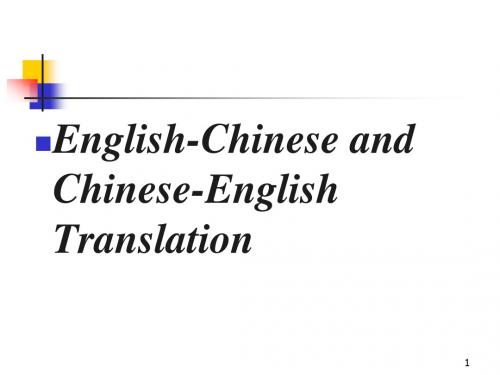
翻译的分类
按翻译进行的媒介可分为 一、笔译(written translation) 按所译体裁可分为文学翻译和非文学翻 译。 1.文学翻译:诗歌、小说、戏剧等文学 体裁的翻译、文学评论 2.非文学翻译:社科作品、科技作品、 新闻、法律文件、应用文
8
二、口译(interpretation) 1.即席口译(consecutive):译员等讲 话人讲完一部分或全部讲完后再翻译给 听众。 2.同声传译(simultaneous):译员在发 言人讲话的同时,边听边译。
2
翻译的定义
一.通俗的定义 《辞海》:把一种语言文字的意义用另一种语 言文字表达出来。 《牛津英语词典》:在保留意义的情况下从一 种语言转变成另一种语言。 《现代法语典》:从一种语言变成另一种语言。
3
二、文艺学的定义 从文艺学的角度解释翻译,认为翻译是艺术创作的一 种形式,强调语言的创造功能,讲究译品的艺术效果 1.文学翻译是“传达作者的全部意图即通过艺术手法 影响读者的思想、感情。” 2.茅盾:文学的翻译是用另一种语言,把原作的艺术 意境传达出来。 3.翻译是把一种语言文字所表达的思想内容和艺术风 格正确无误地、恰如其分地转移到另一种语言文字中 去的创造性活动。
14
翻译的历史,实际上就是政治、经济和 文化的交流史。从远古时代起,随着各 民族的交往、商业贸易的开通、文化的 交流、宗教的传播,翻译工作也就开始 了。我国二千多年的翻译历史为我们积 累了一份宝贵的文化财富,这是我国文 化的重要组成部分,与我们的文学史、 科技史、文化史一样,应该等价齐观。
15
English-Chinese and Chinese-English Translation
1
翻译课要学什么?
翻译理论

翻译理论一、翻译定义:1. 张培基——翻译是用一种语言把另一种语言所表达的思维内容准确而完整地重新表达出来的语言活动。
3. 刘宓庆——翻译的实质是语际的意义转换。
4. 王克非——翻译是将一种语言文字所蕴含的意思用另一种语言文字表达出来的文化活动。
5. 泰特勒——好的翻译应该是把原作的长处完全地移注到另一种语言,以使译入语所属国家的本地人能明白地领悟、强烈地感受,如同使用原作语言的人所领悟、所感受的一样。
6. 费道罗夫——翻译就是用一种语言把另一种语言在内容与形式不可分割的统一中所业已表达出来的东西准确而完全地表达出来。
7. 卡特福德——翻译的定义也可以这样说:把一种语言(Source Language)中的篇章材料用另一种语言(Target Language)中的篇章材料来加以代替。
8. 奈达——翻译就是在译入语中再现与原语信息最切近的自然对等物,首先就意义而言,其次就是文体而言。
9. 巴尔胡达罗夫——翻译是把一种语言的语言产物在保持内容方面(也就是意义)不变的情况下改变为另一种语言的语言产物的过程。
纽马克——通常(虽然不能说总是如此),翻译就是把一个文本的意义按作者所想的方式移译入另一种文字(语言)。
10. “Translation is the expression in one language (ortarget language译入语) of what has been expressed in anotherlanguage (source language 原语), preserving semantic and stylisticequivalences.”--- Dubois11. “Translating consists in reproducing in thereceptor language the closest natural equivalent of the source languagemessage, first in terms of meaning and secondly in terms of style.”---EugeneNida12. “Translation is a craft consisting in the attemptto replace a written message and/or statement in one language by the samemessage and/or statement in another language.”--- Peter Newmark13.Translation or translating is a communicativeactivity or dynamic process in which the translator makes great effort tothoroughly comprehend a written message or text in the sourcelanguage andworks very hard to achieve an adequate or an almost identical reproduction inthe target language version of the written source language message or text.二、翻译标准1. 翻译的标准概括为言简意赅的四个字:“忠实(faithfulness)、通顺(smoothness)”。
大学英语翻译概论

01
诗歌翻译三美原则:意美、音美、形美
02
Beauty in Sense, Sound, Style
许渊冲
美国 奈达 Eugene Nida: 读者反应论
01
(Receptor’s response)
02
忠实原文
03
易于理解
04
形式恰当
05
吸引读者
06
01
Equivalence
与原文作用相符(表达方面的等值)
01
02
国际译联主席Betty Cohen:Never in history have we been so indispensable to trade, culture, peace, and humanity…Just imagine one day in the world without translation…would all be mute. We are like the electricity in the wires and the water in the tap.
04
A musician / an actor
03
关于译者的比喻:
2.The purpose of translation
交流信息,克服语言障碍
01
特定文本的翻译具有其特定的目的,有其预设的读者群
04
学习其他语言的文化和文明,帮助向更高的文明发展
02
帮助经济、政治等各方面的交流和发展
03
Translatability and untranslatability (Language / Cultural Barriers) Translatability is lower when (1) the work to be translated is quite distant both in time and space; (2) its form is very much unique; (3) the content is not shared in the two cultures.
第一章 翻译的基本概念与知识
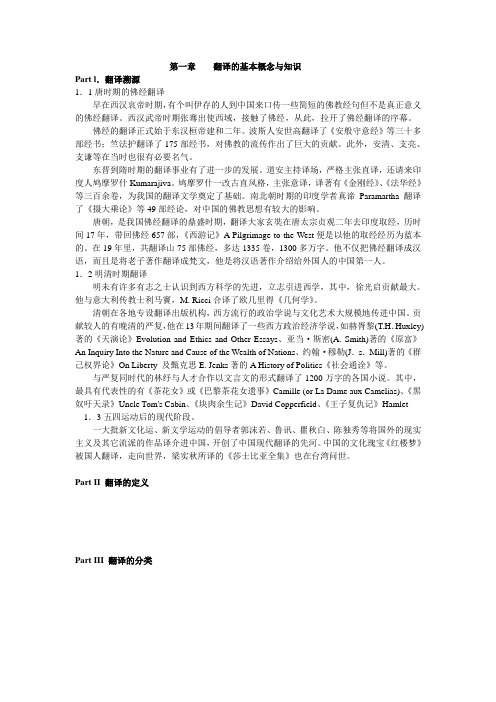
第一章翻译的基本概念与知识Part l.翻译溯源1.1唐时期的佛经翻译早在西汉哀帝时期,有个叫伊存的人到中国来口传一些简短的佛教经句但不是真正意义的佛经翻译。
西汉武帝时期张骞出使西域,接触了佛经,从此,拉开了佛经翻译的序幕。
佛经的翻译正式始于东汉桓帝建和二年。
波斯人安世高翻译了《安般守意经》等三十多部经书;竺法护翻译了175部经书,对佛教的流传作出了巨大的贡献。
此外,安清、支亮、支谦等在当时也很有必要名气。
东晋到隋时期的翻译事业有了进一步的发展。
道安主持译场,严格主张直译,还请来印度人鸠摩罗什Kumarajiva。
鸠摩罗什一改古直风格,主张意译,译著有《金刚经》、《法华经》等三百余卷,为我国的翻译文学奠定了基础。
南北朝时期的印度学者真谛Paramartha翻译了《摄大乘论》等49部经论,对中国的佛教思想有较大的影响。
唐朝,是我国佛经翻译的鼎盛时期,翻译大家玄奘在唐太宗贞观二年去印度取经,历时间17年,带回佛经657部,《西游记》A Pilgrimage to the West便是以他的取经经历为蓝本的。
在19年里,共翻译山75部佛经,多达1335卷,1300多万字。
他不仅把佛经翻译成汉语,而且是将老子著作翻译成梵文,他是将汉语著作介绍给外国人的中国第一人。
1.2明清时期翻译明未有许多有志之士认识到西方科学的先进,立志引进西学,其中,徐光启贡献最大。
他与意大利传教士利马竇,M. Ricci合译了欧几里得《几何学》。
清朝在各地专设翻译出版机构,西方流行的政治学说与文化艺术大规模地传进中国。
贡献较人的有晚清的严复,他在13年期间翻译了一些西方政治经济学说,如赫胥黎(T.H.Huxley)著的《天演论》Evolution and Ethics and Other Essays、亚当·斯密(A. Smith)著的《原富》An Inquiry Into the Nature and Cause of the Wealth of Nations、约翰·穆勒(J.s.Mill)著的《群己权界论》On Liberty 及甄克思E. Jenks著的A History of Politics《社会通诠》等。
一、翻译简介

Appreciation
From there I can the whole valley below, the fields, the river, and the village. It is all very beautiful, and the sight of it filled me with longing . 从这里望下去,整个山谷一览无余。只见那田野、 从这里望下去,整个山谷一览无余。只见那田野、河 流和村庄,全都美不胜收, 流和村庄,全都美不胜收,真叫我心驰神往 The air war heats up as the air war heats up. 空袭一开始,媒体大战也就登场了。 空ne
Introduction
I.翻译的定义Definition
Turn from one language into another The Oxford English Dictionary 把一种语言文字的意义用另一种语言文字表达出来《辞海》 把一种语言文字的意义用另一种语言文字表达出来《辞海》 翻译是把一种语言表达的意义用另一种语言表达出来, 翻译是把一种语言表达的意义用另一种语言表达出来,以达到沟 通思想情感、传播文化知识、促进社会文明、 通思想情感、传播文化知识、促进社会文明、特别是推动译语文 化兴旺昌盛的目的。(孙致礼) 化兴旺昌盛的目的。(孙致礼) 。(孙致礼 翻译是技巧skill 翻译是技巧 翻译是语言活动language activity 翻译是语言活动 翻译是交流communication 翻译是交流 翻译是科学science 翻译是科学 翻译是艺术art 翻译是艺术
每一个民族都有别于其他民族的文化, 每一个民族都有别于其他民族的文化,它妨碍和其他民族的相互 理解,甚至会造成文化休克。 理解,甚至会造成文化休克。 用归化译法翻译这些成语、惯用语, 用归化译法翻译这些成语、惯用语,易于被读者理解
翻译资格证考试复习重点资料

翻译资格证考试复习重点资料一、基础知识复
复以下基础知识对于翻译资格证考试至关重要:
- 翻译的定义和分类
- 语言学基础知识:语言的结构、语法、词汇等
- 翻译常用的技巧和方法
- 翻译标准和准则
二、词汇与短语
掌握以下词汇和短语有助于提高翻译能力:
- 常用的高频词汇和表达
- 与翻译相关的专业术语
- 不同领域的词汇和短语,如法律、商务、科技等三、翻译技巧与方法
了解下列翻译技巧和方法会帮助你更好地应对考试:
- 文化背景和语境的重要性
- 同义词和反义词的转换
- 上下文推断翻译
- 语法和结构的转换技巧
四、常见的翻译难点
熟悉以下常见的翻译难点,能够帮助你应对考试中的挑战:- 语义多义性和歧义的处理
- 文化差异对翻译的影响
- 意译与直译的选择
- 长句和复杂句的翻译技巧
五、模拟试题和练
为了更好地备考,建议进行模拟试题和练:
- 寻找翻译资格证考试的模拟试题并进行练
- 阅读与翻译相关的文章和资料,积累经验和提高翻译速度- 找到合适的练资源,如翻译练册或在线翻译平台
以上是翻译资格证考试复习的重点资料,希望能对你的备考有所帮助。
祝你考试顺利!。
翻译的基本概念

整个天空点缀着繁星,快活地扎眼。天 河那么清楚地显现出来,就好像有人在 过节以前用雪把它擦洗过似的。 天上闪耀着光明的亮星,牛奶路很白, 好像是礼拜日用雪擦洗过的一样。 ----赵景深译
3.3 异化(dissimilation) 和归化 (domestication) 异化:转达原文意思的时候,是译文的表达形 式和句法结构尽量同原文一致起来,能完全对 等的就完全对等,不能完全对等的也要大致对 等。 优点:保留的原文的文化意象,目的是使译文 保持原文的语言风格,向译文读者介绍源语文 化,并丰富译入语及文化。 ----Venuti, Lawrence. 1995. The translator’s Invisibility. London: Routledge.
化境论(fairy):把作品从一国文字转变成 另一国文字,既能不因语文习惯的差异 而露出生硬牵强的痕迹,又能完全保存 原作的风味,那就算得入于化境。 钱钟书 《林纾的翻译》
The whole sky spangled gay twinkling stars, and the Milky Way is as distinct as though it had been washed and rubbed with snow for holiday. ----英著名俄罗斯古典文学家翻译 家加内特夫人(Garnet Constance) 译契 科夫《樊凯》
In this example “a cultural unit” means “一个文化单元” in Chinese, and is not what the Chinese people called “文化单 位 ,” which should correctly be translated into “a historical site.”
我国翻译史,定义及分类(第一章)
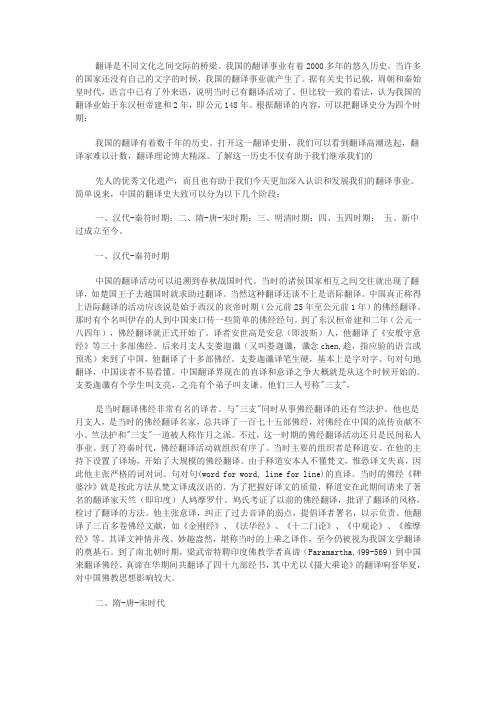
翻译是不同文化之间交际的桥梁。
我国的翻译事业有着2000多年的悠久历史。
当许多的国家还没有自己的文字的时候,我国的翻译事业就产生了。
据有关史书记载,周朝和秦始皇时代,语言中已有了外来语,说明当时已有翻译活动了。
但比较一致的看法,认为我国的翻译业始于东汉桓帝建和2年,即公元148年。
根据翻译的内容,可以把翻译史分为四个时期:我国的翻译有着数千年的历史。
打开这一翻译史册,我们可以看到翻译高潮迭起,翻译家难以计数,翻译理论博大精深。
了解这一历史不仅有助于我们继承我们的先人的优秀文化遗产,而且也有助于我们今天更加深入认识和发展我们的翻译事业。
简单说来,中国的翻译史大致可以分为以下几个阶段:一、汉代-秦符时期;二、隋-唐-宋时期;三、明清时期;四、五四时期;五、新中过成立至今。
一、汉代-秦符时期中国的翻译活动可以追溯到春秋战国时代。
当时的诸侯国家相互之间交往就出现了翻译,如楚国王子去越国时就求助过翻译。
当然这种翻译还谈不上是语际翻译。
中国真正称得上语际翻译的活动应该说是始于西汉的哀帝时期(公元前25年至公元前1年)的佛经翻译。
那时有个名叫伊存的人到中国来口传一些简单的佛经经句。
到了东汉桓帝建和二年(公元一八四年),佛经翻译就正式开始了。
译者安世高是安息(即波斯)人,他翻译了《安般守意经》等三十多部佛经。
后来月支人支娄迦谶(又叫娄迦谶,谶念chen,趁,指应验的语言或预兆)来到了中国,他翻译了十多部佛经。
支娄迦谶译笔生硬,基本上是字对字、句对句地翻译,中国读者不易看懂。
中国翻译界现在的直译和意译之争大概就是从这个时候开始的。
支娄迦谶有个学生叫支亮,之亮有个弟子叫支谦。
他们三人号称"三支",是当时翻译佛经非常有名的译者。
与"三支"同时从事佛经翻译的还有竺法护。
他也是月支人,是当时的佛经翻译名家,总共译了一百七十五部佛经,对佛经在中国的流传贡献不小。
竺法护和"三支"一道被人称作月之派。
1.翻译的定义、分类和中西名实观

7.加切齐拉泽:文艺翻译是把用一种语言写成的作品 ,用另一种语音再造出来。 8.张培基等:翻译是运用一种语言把另一种语言所表 达的思维内容,准确而完整地重新表达出来的语言活动 9. Susan Bassnett Andre Lefevere: Translation is, of course, a rewriting of an original text. 10. Zhong Shukong: Translation, essentially, is the faithful representation in one language of what is written or said in another language.2 Nhomakorabea09-2
(一)关于翻译的界定
1.《周礼义疏》:译即易,谓换易言语使相解也。 2.傅雷:以效果而论,翻译应当像临画一样,所求的 不在形似而在神似。 3.钱钟书:文学翻译的最高标准是“化境”(“投胎 转世”, The Transmigration of Souls)。 4.茅盾:文学翻译是用一种语言,把原作的艺术意境 传达出来,使读者在读译文的时候能够像读原作一样得 到启发、感动和美的感受。 5.余光中:如果原作者是神灵,则译者就是巫师,任 务是把神谕传给凡人。译者介于神人之间,既要通天意 ,又要说人话,真是左右难为巫。
在总结其长期的诗歌翻译经验中,当代著名翻译家 许渊冲先生在1979年提出了诗歌译的三原则,即意美 、音美、形美。在三美中,意美是第一位的,是最重要 的;音美是第二位的,次要的;形美是第三位的,是更 次要的,在诗歌翻译中,译者应尽可能做到“三美”齐 备。美国诗人、翻译家庞德( Ezra Pound)通过总结 其翻译中国古典诗歌和创立意象主义诗歌的经验,提出 了诗歌翻译应做到“形文”、“直文”和“情文”( phanopoeia, melopoeia, logopoeia)。这些观点在 长期的翻译实践中,起着重要的指导作用。
翻译概念
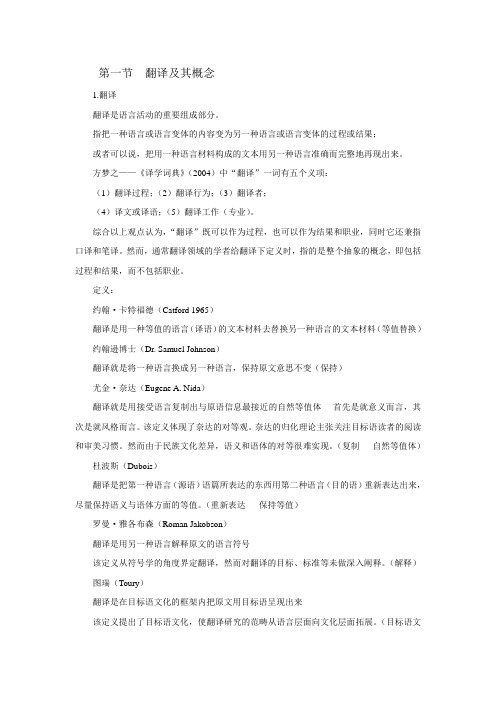
第一节翻译及其概念1.翻译翻译是语言活动的重要组成部分。
指把一种语言或语言变体的内容变为另一种语言或语言变体的过程或结果;或者可以说,把用一种语言材料构成的文本用另一种语言准确而完整地再现出来。
方梦之——《译学词典》(2004)中“翻译”一词有五个义项:(1)翻译过程;(2)翻译行为;(3)翻译者;(4)译文或译语;(5)翻译工作(专业)。
综合以上观点认为,“翻译”既可以作为过程,也可以作为结果和职业,同时它还兼指口译和笔译。
然而,通常翻译领域的学者给翻译下定义时,指的是整个抽象的概念,即包括过程和结果,而不包括职业。
定义:约翰·卡特福德(Catford 1965)翻译是用一种等值的语言(译语)的文本材料去替换另一种语言的文本材料(等值替换)约翰逊博士(Dr. Samuel Johnson)翻译就是将一种语言换成另一种语言,保持原文意思不变(保持)尤金·奈达(Eugene A. Nida)翻译就是用接受语言复制出与原语信息最接近的自然等值体----首先是就意义而言,其次是就风格而言。
该定义体现了奈达的对等观。
奈达的归化理论主张关注目标语读者的阅读和审美习惯。
然而由于民族文化差异,语义和语体的对等很难实现。
(复制自然等值体)杜波斯(Dubois)翻译是把第一种语言(源语)语篇所表达的东西用第二种语言(目的语)重新表达出来,尽量保持语义与语体方面的等值。
(重新表达保持等值)罗曼·雅各布森(Roman Jakobson)翻译是用另一种语言解释原文的语言符号该定义从符号学的角度界定翻译,然而对翻译的目标、标准等未做深入阐释。
(解释)图瑞(Toury)翻译是在目标语文化的框架内把原文用目标语呈现出来该定义提出了目标语文化,使翻译研究的范畴从语言层面向文化层面拓展。
(目标语文化)哈提姆和梅森(Basil Hatim & Ian Mason)翻译是一种在某社会语境中发生的交际过程。
英语翻译的定义,范例讲解
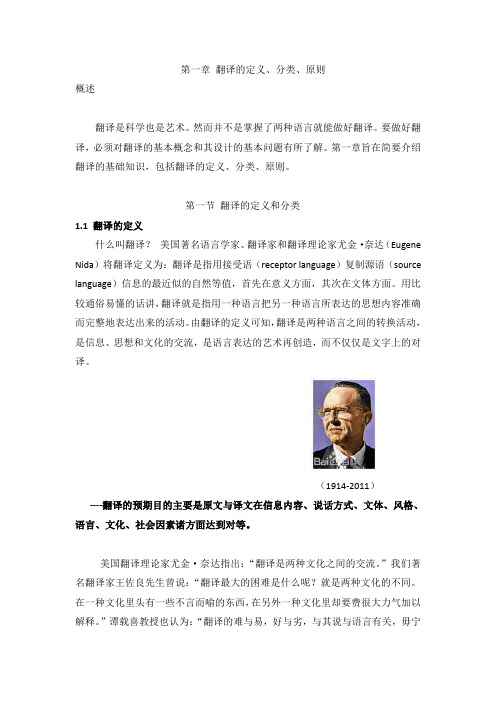
第一章翻译的定义、分类、原则概述翻译是科学也是艺术。
然而并不是掌握了两种语言就能做好翻译。
要做好翻译,必须对翻译的基本概念和其设计的基本问题有所了解。
第一章旨在简要介绍翻译的基础知识,包括翻译的定义、分类、原则。
第一节翻译的定义和分类1.1 翻译的定义什么叫翻译?美国著名语言学家、翻译家和翻译理论家尤金·奈达(Eugene Nida)将翻译定义为:翻译是指用接受语(receptor language)复制源语(source language)信息的最近似的自然等值,首先在意义方面,其次在文体方面。
用比较通俗易懂的话讲,翻译就是指用一种语言把另一种语言所表达的思想内容准确而完整地表达出来的活动。
由翻译的定义可知,翻译是两种语言之间的转换活动,是信息、思想和文化的交流,是语言表达的艺术再创造,而不仅仅是文字上的对译。
(1914-2011)----翻译的预期目的主要是原文与译文在信息内容、说话方式、文体、风格、语言、文化、社会因素诸方面达到对等。
美国翻译理论家尤金·奈达指出:“翻译是两种文化之间的交流。
”我们著名翻译家王佐良先生曾说:“翻译最大的困难是什么呢?就是两种文化的不同。
在一种文化里头有一些不言而喻的东西,在另外一种文化里却要费很大力气加以解释。
”谭载喜教授也认为:“翻译的难与易,好与劣,与其说与语言有关,毋宁说主要与文化有关。
”翻译是源语文化与译语文化的共同行为,译著是源语文化与译语文化相互作用的结果。
翻译改造了文化异质,同时又保持了文化异质。
翻译所展示的文化既不是彻底的源语文化,又不是彻底的译语文化,而是一种具有本土化的异质文化,一种让读者既熟悉又陌生的文化。
所谓文化“传真”就是要求译语从文化意义的角度准确地再现源语文化所要传达的意义、形式与风格,它是文化翻译的基本准则。
示例拿红楼梦来说,就有许多不同的版本。
著名红学专家周汝昌说:“《红楼梦》是我们中华民族的一部古往今来、绝无仅有的‘文化小说’。
英语翻译的定义,范例讲解
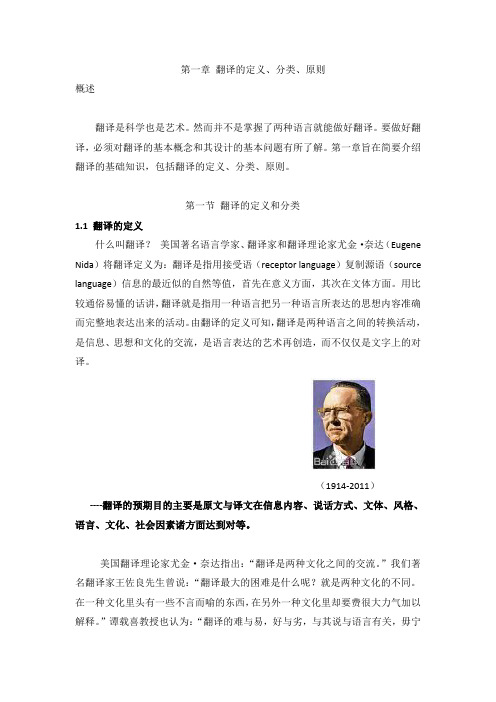
第一章翻译的定义、分类、原则概述翻译是科学也是艺术。
然而并不是掌握了两种语言就能做好翻译。
要做好翻译,必须对翻译的基本概念和其设计的基本问题有所了解。
第一章旨在简要介绍翻译的基础知识,包括翻译的定义、分类、原则。
第一节翻译的定义和分类1.1 翻译的定义什么叫翻译?美国著名语言学家、翻译家和翻译理论家尤金·奈达(Eugene Nida)将翻译定义为:翻译是指用接受语(receptor language)复制源语(source language)信息的最近似的自然等值,首先在意义方面,其次在文体方面。
用比较通俗易懂的话讲,翻译就是指用一种语言把另一种语言所表达的思想内容准确而完整地表达出来的活动。
由翻译的定义可知,翻译是两种语言之间的转换活动,是信息、思想和文化的交流,是语言表达的艺术再创造,而不仅仅是文字上的对译。
(1914-2011)----翻译的预期目的主要是原文与译文在信息内容、说话方式、文体、风格、语言、文化、社会因素诸方面达到对等。
美国翻译理论家尤金·奈达指出:“翻译是两种文化之间的交流。
”我们著名翻译家王佐良先生曾说:“翻译最大的困难是什么呢?就是两种文化的不同。
在一种文化里头有一些不言而喻的东西,在另外一种文化里却要费很大力气加以解释。
”谭载喜教授也认为:“翻译的难与易,好与劣,与其说与语言有关,毋宁说主要与文化有关。
”翻译是源语文化与译语文化的共同行为,译著是源语文化与译语文化相互作用的结果。
翻译改造了文化异质,同时又保持了文化异质。
翻译所展示的文化既不是彻底的源语文化,又不是彻底的译语文化,而是一种具有本土化的异质文化,一种让读者既熟悉又陌生的文化。
所谓文化“传真”就是要求译语从文化意义的角度准确地再现源语文化所要传达的意义、形式与风格,它是文化翻译的基本准则。
示例拿红楼梦来说,就有许多不同的版本。
著名红学专家周汝昌说:“《红楼梦》是我们中华民族的一部古往今来、绝无仅有的‘文化小说’。
- 1、下载文档前请自行甄别文档内容的完整性,平台不提供额外的编辑、内容补充、找答案等附加服务。
- 2、"仅部分预览"的文档,不可在线预览部分如存在完整性等问题,可反馈申请退款(可完整预览的文档不适用该条件!)。
- 3、如文档侵犯您的权益,请联系客服反馈,我们会尽快为您处理(人工客服工作时间:9:00-18:30)。
Definition of translation1) 翻译是跨语言、跨文化、跨社会(cross-social)的交际活动。
2) 翻译是将一种语言文化承载的意义转换到另一种语言文化中的跨语言,跨文化的交际活动。
Translation is a representation or recreation in one language of what is written or said in another language.3)翻译的本质是释义,是意义的转换. meaning-based汉译英是译者将作者为汉语读者所写的汉语文本转换成功能相似、语义相符、供英文读者阅读的英语文本的活动。
Classification of translation1)Translation—— Intralingual translation(语内翻译);Interlingualtranslation(语际翻译);Intersemiotic translation(符际翻译)2) Interlingual translation——Oral (interpretation) : consecutive(交替传译); simultaneous(同声传译)3) Written: whole text literature; pragmatic excerpt; selective; adapted; rewriting; MAT & MTCriteria of translationCriteria of translation is the plumb-line for measuring the quality of a translation and the goal for a translator to strive for.1) Source-language–oriented principle(以译出语为取向的原则)Characteristics: pay extreme attention to the form of the source text, always adopts a word-for-word / line-for-line translation or transliteration.•他是只纸老虎He is a paper tiger.•这事让他丢脸This makes him lose face.2) Target-language-oriented principle (以译入语为取向的原则) Liberal translation: using large number of domestication / adaptationfor the reader’s sake. This is done at the cost of the loss or damage of the original image sometimes.•What is done is done. 木已成舟•Kicking a man when he is down. 打落水狗/落井下石•三个臭皮匠,合成一个诸葛亮Two heads are better than one.3)Author-and-reader-oriented principle (以作者和读者为取向的原则) Characteristics: take both the author and the reader into consideration, and strive to be faithful and smooth at the same time.•繁华也罢,贫穷也罢,丈夫和妻子携手一生,情深意长。
•For richer or for poorer, the husband and the wife are a loving couple for life.4)Socio-semiotics-oriented principle (以社会符号学为取向的原则) Characteristics: the translator should take into consideration the meaning and function conveyed by all kinds of language symbols included.•符号学的翻译原则:在保证特定上下文中最重要的意义优先传译的前提下,尽可能多地传递原语信息的多重意义,以争取原文和译文最大限度的等值。
18世纪英国爱丁堡大学教授,翻译理论家泰特勒(Alexander F. Tytler)提出的三条翻译基本原理:•1. A translation should give a complete transcript of the ideas of the original work. (译文应该完全传达原文的思想)•2. The style and manner of writing should be of the same character as that of the original. (译文的风格与笔调应与原文的一致)•3. A translation should have all the ease of the original composition. (译文应像原文一样流畅)•玄奘: 既须求真又须喻俗•严复: (《天演论》卷首的《译例言》) “信、达、雅”(faithfulness, expressiveness and elegance)•“译事三难:信,达,雅。
求其信已大难矣,顾信矣不达,虽择犹不择也,则达尚焉A)Designative/conceptual meaning (指称意义):The relationship between the language symbol and the objective world it refers to•flower(花)•He can play football. (他会踢球)B)Linguistic meaning (言内意义):The relationship between language symbols in the level of phonetics, word syntactic and discourse.•The senator picked up his hat and courage.参议员捡起了帽子,鼓起了勇气.(一语双叙)•Two ghosts walked into a bar and asked the bar tender, “Do you serve spirits?”C) Pragmatic meaning (语用意义):It refers to the relationship between language symbols and its user, including indexical meaning(表征意义), expressive meaning(表情意义), social meaning(社会意义), imperative meaning(祈使意义), associative meaning(联想意义).Leech(1974: 10-26)意义七分说1. 概念意义(conceptual meaning) dictionary meaning2. 主题意义(thematic meaning) word order, emphasis…3. 联想意义(associative meaning) man, woman4. 含蓄意义(connotative meaning) 小姐5. 文体意义(stylistic meaning) social environment dialect,6. 情感意义(affective meaning) emotion7. 折射意义(reflected meaning) taboo, euphemism8. 搭配意义(collocative meaning) good day, good job对语言具备的功能,翻译家和语言学家的看法基本一致,只是划分的类别出有粗细之分,综合各家之见,(陈宏薇将之)分为:1. 信息功能(informative function)e.g. Gold melts at 300 degrees Fahrenheit.2. 表情功能(expressive function)e.g. I’m extremely sorry about…3. 人际/寒暄功能(interpersonal / phatic function)e.g. How are you?Thank you for being with us! Good night!4. 呼唤/祈使功能(vocative function)e.g. Come here!5. 美感功能(aesthetic function)e.g. My love’s a red rose.6. 认知功能(cognitive function) *man has to use language to think , during the process, the language is performing the ~7. 元语言功能(metalingual function)e.g. Chinese is a tonal language.汉译英操作步骤1、划分逻辑层次A.尽量把一个逻辑层次翻译成一个句子B.当逻辑层次较多,无法翻译成一个句子时,要注意句子与句子间的关联2、确定每一个句子的主干3、在主语谓语的基础上添加修饰成分4、最后进行全文检查先找到主语再找到与主语对应的谓语动词,然后再进行修饰小知识:People是与自然对应的,而human being是与动物对应的。
